Figure 7.

A model connecting telomere damage signalling and senescence-associated replicative arrest. As a consequence of cumulative cell divisions, a DNA DSB signal is generated either directly via exposure of critically shortened telomere or indirectly via chromosomal breaks, which may occur as a consequence of chromosome fusion and breakage following critical telomere shortening. These events elicit an ATM-dependent and -independent phosphorylation of targets including H2AX and Chk2. Activated Chk2 could further propagate the signal via a downstream substrate such as p53, which would in turn activate the transcription of the cell cycle inhibitor p21, leading to replicative arrest. Other intermediates and co-factors in the signalling pathway from the senescence-associated DNA damage to p53 activation are undoubtedly necessary.
